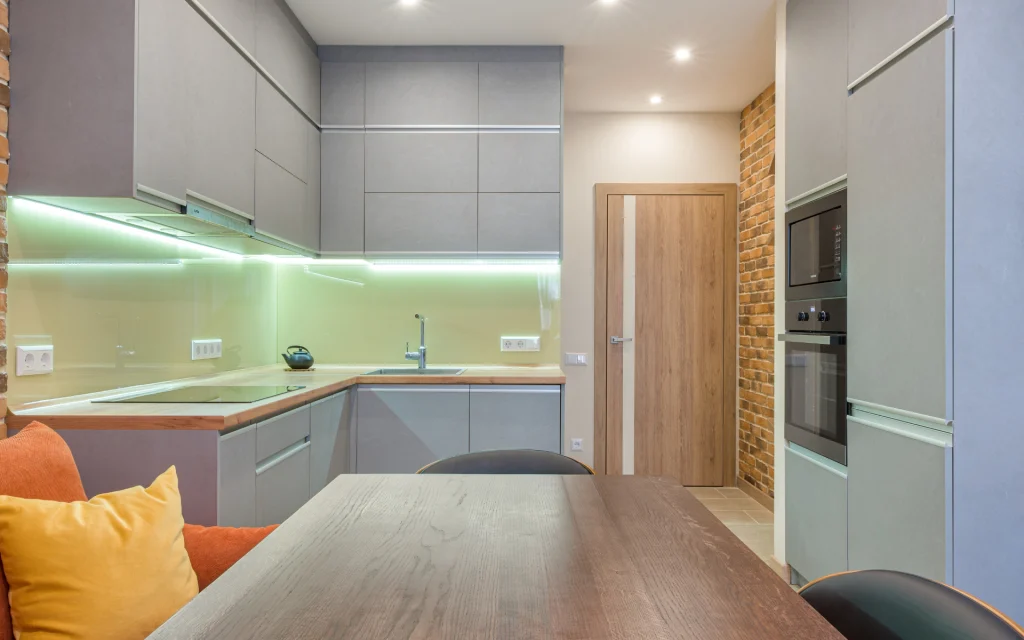
Consider Cabinet Lighting Needs and Usage
The first step is deciding what purpose your new cabinet lighting needs to serve. Analyze how your other kitchen lighting is used and where you need more light. Typical needs include:
- Task lighting over key work zones like countertops, sinks, or stoves
- Accent lighting to illuminate decorative displays in glass cabinet fronts
- Ambient lighting for overall illumination in dim corners
- Safety lighting along floors or steps to improve visibility
Consider when you use your home or kitchen most to determine when lighting is needed most. For example, install under kitchen cabinet lights to aid in late-night snacking or early breakfast prep.
Choose Fixtures and Locations
Consider light fixture types suited to your cabinet locations, color and lighting goals:

Puck Lights
Puck lights provide focused task lighting. Small, round, and easily tucked inside cabinets, these miniature lights shine down onto work surfaces and onto counter workspaces when installed on cabinet undersides or ceilings. Puck lights work well spaced at regular intervals underneath wall cabinets. Opt for a dimmable LED puck light.
Tape Light
For under cabinet illumination, slim LED lighting offers an inconspicuous, modern option. Tape lights mount directly to cabinet bottoms and ceiling lights provide uniform lighting across the strip length. Choose from diffused lights or clear bulb options. Link multiple light strips for expanded lighting.

LED Light Bar
Distinctive linear light bars often mount horizontally under cabinets for bold and versatile accent lighting. Sleek and contemporary, light bars cast colorful glows perfect for highlighting specific work zones or displays.
Rail Lights
Attached to the top cabinet frame facing down, rail lights wash vertical surfaces in soft illumination. Use along upper cabinets, hutches, or display cabinets and shelving.
Toe-Kick Lights
Toe-kick lighting runs along the recessed base of lower cabinets for subtle safety lighting and illumination. Useful for navigating tight or dim kitchens.
Cabinet Interior Lights
Installing strip lighting or puck lights inside cabinets illuminates contents and creates a spotlight effect behind glass-front doors. Use inside ceiling lighting to create living displays of collectibles.
Choose locations that align with how you use your kitchen. Focus task lighting where you prep and cook. Add accent lighting where you want to highlight decorative displays.

Select Cabinet Lighting Features
Today’s cabinet lighting offers many features to match your needs:
- Dimmable – Dimmable lights allow you to control brightness levels to set just the right ambiance for cooking, parties, or late nights.
- Smart – Smart options let you turn lights on/off, dim, change colors, and automate via app controls and voice assistants.
- Warm vs. Cool Light – Choose warmer light temperatures (2700-3000K) for a cozy vibe, or cooler temps (3500-4000K) for task visibility.
- Hardwired vs. Plug-In – Hardwired provides a seamless look, while plug-in offers more flexibility. Consider existing electrical setups and placement.
- Safety Rated – Ensure under-cabinet fixtures are safety-rated to prevent fire risks from heat exposure. Damp-rated for kitchens.
- Energy Efficient – Choose LEDs that use minimal energy yet output optimal light compared to older lighting technology.
- Colors – Strip lighting often comes in RGB variants able to produce a spectrum of colors. Use accent colors sparingly.
Select features to provide the right cabinet lighting functionality suitable for your needs and kitchen design.

Plan Cabinet Lighting Installation
Proper installation of your cabinet lighting ensures it works safely and effectively:
- Review electrical load capacity and wiring needs. Upgrade electrical if needed.
- Choose hardwired lights or plug-in fixtures based on ease of installation and your kitchen layout.
- Map out exact lighting placement for best coverage of key countertop tasks, displays, and hazard zones.
- Ensure adequate task lighting by positioning lights close to the front cabinet edge, spaced at regular intervals.
- Install led tape lighting using sturdy adhesive and clips to tightly affix to cabinet undersides.
- Carefully measure and cut tape or rail lights to fit each cabinet span perfectly.
- Place puck lights strategically within cabinets to optimize the light cone coverage.
- Link multiple lights to switches for simple on/off control. Use dimmers appropriate for the fixture.
- Follow all electrical codes and manufacturer instructions carefully for safety.
Proper planning and installation ensure your new cabinet lighting provides optimal visibility, safety, performance and design impact.
Wrap-Up
The benefits of incorporating kitchen cabinet lighting are undeniable. Cabinet lighting saves money over expensive overall remodels by transforming kitchens through focused, functional illumination. Carefully installed and designed lighting shines light on tasks, eliminates dark corners, creates dramatic focal displays, and boosts kitchen safety. With today’s wafer-thin, flexible LED options, it’s easy to incorporate cabinet lighting seamlessly into your kitchen. Let cabinet lighting be the upgrade that takes your kitchen functionality and style into the modern era.

